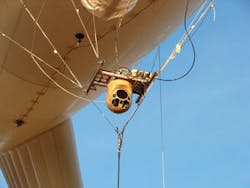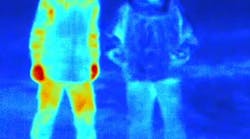By John McHale
WILSONVILLE, Ore. - Sensor designers at FLIR Systems found that mil-spec requirements were falling short in the desert and other harsh environments where U.S. warfighters find themselves today, so they changed test procedures, chambers, and equipment to push their products beyond what is already a stringent standard.
Tests they set up for dust, water, wave slap, etc., did not reliably account for different sizes of dust particles and high-pressure waves, among other conditions in these climates. For salt spray, FLIR experts developed more stringent specifications and new test chambers.
“We have found in Southwest Asia theater, products need more qualification to make sure they perform the way they should,” particularly products qualified to MIL-STD 810, says David Strong, vice president of marketing at FLIR Government Systems in Wilsonville, Ore.
FLIR engineers redesigned MIL-STD 810F test systems for their SeaFLIR and TacFLIR products to more accurately measure reliability, Strong says.
The water impingement/wave slap initial design was qualified to MIL-STD 810F for blowing rain, Strong says. “Through field data analysis and customer feedback, it was determined that the operating environment [special operations craft operating at high speeds in high seas] was much more severe than what the system was being subjected to during Mil-Spec testing.”
FLIR Systems experts carried out a self-funded pre-planned product improvement program on six design iterations. Each design iteration was tested to failure using varying degrees of water pressure focused directly on seal interfaces,” Strong says. This is distinct from MIL-STD testing that involves one continuous pressure and condition. “The sixth iteration was analyzed by an independent contractor and tested extensively to identify any additional possible failure modes,” he says. “None was found. To date more than 150 systems with the R6 seal have been deployed and not a single failure has been identified.”
Regarding sand and dust testing, MIL-STD 810F test guidelines call for one particulate diameter, Strong says. In real-world environments, sand and dust particulate diameters vary significantly, so testing and qualifying to one particulate size does little to guarantee reliable operation of fielded systems-particularly in the deserts of the Middle East where dust can be as fine as talcum powder.
“To optimize the seal and lens designs, FLIR Systems was given an actual sample of sand and dust collected by an end user in the systems’ primary operating environment,” Strong says. “FLIR Systems analyzed the physical properties and used this data in conjunction with the water/wave slap and salt spray testing to optimize the gimbal-seal and lens-coating designs.”
FLIR took a similar sand/dust approach with their BRITE Star and BRITE Star II thermal-imaging laser designator systems, Strong says. “We used a sample of in-theater sand to verify functionality of the cooling system for the laser designator, which includes protective screening and internal portions of the cooling unit. The MIL-STD-810 test was not practical enough, because in the real world the design must allow the small particles to pass through the system while blocking the big stuff, but not clog. Testing with the real-world material confirmed the design and the system have performed flawlessly in theater.”
For salt resistance MIL-STD 810F salt-fog testing guidelines call for exposing hardware to a vaporized salt-water solution, with a limited test duration of typically four to six days, Strong explains.
“FLIR, going beyond the mil-spec, researched the salinity of the Persian Gulf and constructed our own salt-spray chamber that replicated its high-salt-spray concentrations,” Strong continues. Engineers used the chamber to determine the influence of extended periods of exposure. They learned valuable lessons and made appropriate design changes, such as new hard carbon lens coatings for greater scratch resistance and more powerful drive systems to overcome friction from salt buildup.
“As a direct byproduct of these efforts, FLIR Systems has developed a seal design that is virtually impervious to saltwater and sand and dust impingement,” Strong says. FLIR received a U.S. patent for the new seal design and now uses it on all maritime and land gimbaled systems, including SeaFLIR II/III, TacFLIR II/III, MARFLIR, Combatant Craft FLIR, SIRVSS AN/MAD-1, and SeaStar III.
For more information on FLIR Government Systems, visit www.flir.com/imaging.




